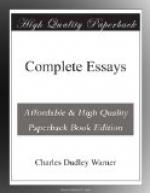Of course the reader sees that the difficulty in considering this subject is whether woman is to be estimated as a work of nature or of art. And here comes in the everlasting question of what is the highest beauty, and what is most to be desired. The Greek artists, it seems to be well established, never used a model, as our artists almost invariably do, in their plastic and pictorial creations. The antique Greek statues, or their copies, which give us the highest conceptions of feminine charm and manly beauty, were made after no woman, or man born of woman, but were creations of the ideal raised to the highest conception by the passionate love and long study of nature, but never by faithful copying of it. The Romans copied the Greek art. The Greek in his best days created the ideal figure, which we love to accept as nature. Generation after generation the Greek learned to draw and learned to observe, until he was able to transmute his knowledge into the forms of grace and beauty which satisfy us as nature at her best; just as the novelist trains all his powers by the observation of life until he is able to transmute all the raw material into a creation of fiction which satisfies us. We may be sure that if the Greek artist had employed the service of models in his studio, his art would have been merely a passing phase in human history. But as it is, the world has ever since been in love with his ideal woman, and still believes in her possibility.
Now the young woman of today should not be deceived into the notion of a preferable Realistic development because the novelist of today gets her to sit to him as his model. This may be no certain indication that she is either good art or good nature. Indeed she may be quite drifting away from the ideal that a woman ought to aim at if we are to have a society that is not always tending into a realistic vulgarity and commonplace. It is perfectly true that a woman is her own excuse for being, and in a way she is doing enough for the world by simply being a woman. It is difficult to rouse her to any sense of her duty as a standard of aspiration. And it is difficult to explain exactly what it is that she is to do. If she asks if she is expected to be a model woman, the reply must be that the world does not much hanker after what—is called the “model woman.” It seems to be more a matter of tendency than anything else. Is she sagging towards Realism or rising towards Idealism? Is she content to be the woman that some of the novelists, and some of the painters also, say she is, or would she prefer to approach that ideal which all the world loves? It is a question of standards.




